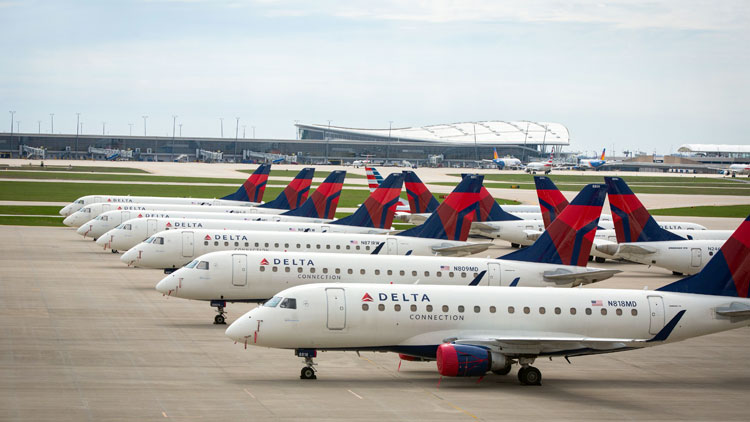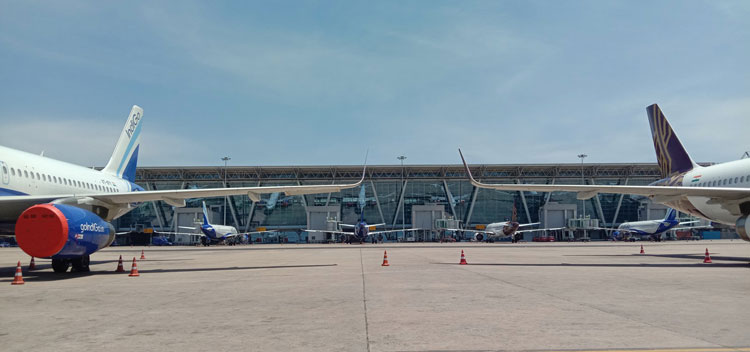Global Airports Council warns against a severe setback for the airports
The airport industry, which employs a large percentage of industry jobs ranging from airport management, maintenance, and security to retail outlets, and others, is expected to be strongly hit by reduced revenues.

The situation around the novel coronavirus (COVID-19) is further getting grimmer and uncertain with no exact answer as to when would all this come to an end and when would the situation normalise. Airports and the aviation industry is going to be among the hardest hit. As travelling will be clouded with skeptical view for quite some time even after the situation comes back to normal, this industry’s growth will certainly be negatively affected. Airports Council International (ACI) Asia-Pacific warned that the prolonged duration of the COVID-19 outbreak will significantly setback the region’s airports from previously forecasted growth prospects. The airport association also urged regulators and governments to implement well-defined adjustments and relief measures tailored to suit local level contexts.
According to the estimates shared by ACI World, the highest impact is being suffered by Asia-Pacific, with passenger traffic volumes down -24 per cent for the first quarter of 2020, compared to forecasted traffic levels without COVID-19. Mainland China, Hong Kong SAR and the Republic of Korea within the Asia-Pacific region, remain at the center of the effects with sizable losses in traffic volumes. Meanwhile, there is a sharp spike in the number of COVID-19 cases in countries across the world, expecting to significantly impact traffic downwards by -4.2 per cent, as travellers and airlines are being left with little scope to adjust their plans and seat offers in the coming days and weeks.
Against this gloomy background of sharp declines in traffic and passenger throughout, airports’ aeronautical revenues and non-aeronautical revenues were rendering similar declines. The ACI World Airport Traffic Forecasts 2019–2040 predicted US$12.4 billion revenue for the first quarter in the Asia-Pacific region in the "business as usual" scenario. The impact of COVID-19 is projected to have a revenue loss of at least US$3 billion.
According to the estimates shared by ACI World, the highest impact is being suffered by Asia-Pacific, with passenger traffic volumes down -24 per cent for the first quarter of 2020, compared to forecasted traffic levels without COVID-19.
Lead by the shortfall in the number of passengers and the cancellation of flights, reduced revenues are also expected from airport charges such as landing and parking charges paid by airlines, and passenger service and security charges paid by passengers. ACI further highlighted that while aeronautical revenues are under pressure, the cost base for airport operations remains unchanged as airports can neither close nor relocate their terminals during the outbreak. When it comes to non-aeronautical sources of revenue, they usually serve as diversification of airport income streams, but they also provide an additional cushion during economic downturns. To a large extent, the COVID-19 initially impacted Chinese passengers, the world’s largest and highest-spending outbound travel group, which in itself created a wider worldwide effect on airports.
“Unlike airlines, who can choose to cancel flights or relocate their aircraft to other markets to reduce operating costs, airport operators manage immovable assets that cannot be closed down. They are faced with immediate cash flow pressures with limited ability to reduce fixed costs and few resources to fund capacity expansion efforts for longer-term future growth,” said Stefano Baronci, Director General of ACI Asia-Pacific. He also added that for privately-held airports, the situation is even worse as they do not benefit from relief measure but are obliged to continue paying concession fees to governments.
The severity of the current situation requires a close cooperation between airport operators and policy stakeholders to identify options to tackle the crisis. “For continued regional prosperity, as all the long-term forecasts suggest, we have to consider the overall sustainability of the sector, starting with the shortage of airport capacity. Asia already manages more than 50 per cent of the super-congested airports in the world and will require to build the large majority of Greenfield airports globally. Further, it is in the interest of the airports to explore at local level with their main partners’ relief measures to face the current challenges and recovery plans to incentivise the return to a normalised market. The blanket application of proposals to reduce airport charges or to freeze the application of the 80/20 rule on airport slots globally should not be supported without passing an economic feasibility test and justification by objective evidence,” Baronci said.
Lead by the shortfall in the number of passengers and the cancellation of flights, reduced revenues are also expected from airport charges such as landing and parking charges paid by airlines, and passenger service and security charges paid by passengers.
Current slot allocation rules require airlines to use at least 80 per cent of their allocated slots under normal operations at an airport in order to keep them. The proposal for a global suspension of 80/20 usage recently made by the International Air Transport Association (IATA) would give airlines the freedom to cancel flights to/from congested airports not necessarily linked to the COVID-19 outbreak, jeopardising the ability for countries to stay connected with the world, which in turn will have knock-on effects on their economies.
Swift Relief Measures Needed to Safeguard Airport Jobs and Connectivity
ACI Asia-Pacific also urged governments (particularly those across the Asia-Pacific and the Middle East region) to swiftly implement relief measures to safeguard airport employment and connectivity. Revised ACI revenue forecasts show the 2020 impact of the pandemic now stands at US$23.9 billion for Asia-Pacific and US$5.7 billion for the Middle East, impacting airports of all sizes. A prolonged outbreak may result in a track volume loss in the range of 1.5 billion passengers for the Asia-Pacific region.

The airport industry in Asia-Pacific and the Middle East employs more than 63 per cent of aviation industry jobs, providing a variety of services ranging from airport management, maintenance, and security to retail outlets, food and beverage and duty-free concessionaires. Taking into account the rapid developments, ACI estimates place the first quarter loss in Asia-Pacific in the range of US$5.6 billion, almost double earlier estimates, a large portion of which comes from the contraction in traffic as well as non-aeronautical revenue. The impact on the Middle East will generate a loss of approximately US$1 billion for the first quarter and at least double for the full year.
“The updated analysis paints an extremely challenging picture for our airport members who have already burnt through about 10 per cent of total yearly revenues in just three months. Every passenger lost by an airline is equally a passenger lost by an airport,” said Baronci. “Relief measures are needed now for the sake of the entire aviation sector’s resilience to save jobs and allow economic recovery.” The crisis is impacting airports of all sizes. Analysis of preliminary weekly passenger data from January to the middle of March at 12 major hubs in Asia-Pacific handling around 22 per cent of traffic in the region, shows the increasing traffic deterioration, culminating in an average decrease in traffic by more than 80 per cent by the second week of March compared to the same period in 2019.
Revised ACI revenue forecasts show the 2020 impact of the pandemic now stands at US$23.9 billion for Asia-Pacificand US$5.7 billion for the Middle East, impacting airports of all sizes.
A number of small airports in the region, those defined by handling less than one million passengers per year, are also heavily affected by the crisis and resulting drop in traffic. The role played by airport networks in several countries in Asia-Pacific and the Middle East will be essential to enable the long-term social and economic benefits of connectivity. ACI Asia-Pacific recommended dedicated funding to keep these small airports operating and ensuring their economic sustainability.
“Legislators have to carefully balance survival and revival measures, addressing both the urgency of short-term needs with smart initiatives that will also facilitate a strong recovery down the road. Several governments are still pondering which measures to apply as the crisis unfolds. ACI Asia-Pacific strongly advocates for policy measures that benefit all parties of the aviation sectors without prejudice in favouring airlines,” added Baronci.
Some specific measures on which ACI Asia-Pacific is calling on governments and regulators to act now and implement include:
- Alleviation of airport slots usage requirements until the end of June 2020: Recognising the ripple effects of pursuing disparate approaches across different countries and airports, ACI World urged a harmonised approach through a global temporary suspension of airport slot usage requirements until June 30, 2020. This temporary suspension of airport slot usage requirements would enable carriers to adjust their schedules in a sustainable way and for airports to protect connecting traffic at hub airports, safeguarding connectivity worldwide. Extension of the temporary suspension beyond June needs to be supported by continuous analysis and flexibly exercised per specific market conditions.
- Tax relief for the aviation sector: This includes suspension or deferment of social security contributions as well as corporate and other taxes (including VAT and excise duties). Suspension of all national and local aviation specific taxes, including passenger departing taxes.
- Suspension or deferment of airport operators’ concession fees to governments: Governments need to consider, on a case-by-case basis, waiving airport rents and concession fees applicable to airport operators, irrespective of ownership status, given the financial stress they are experiencing.
- Protection of airport revenues to finance operations, and bear high fixed cost: Airports rely on revenue from charges on airlines, passengers and commercial activities. Any global alleviation of airport charges or introduction of blanket discounts, therefore, will place airport operators in greater financial distress.
- Government financial assistance: In some circumstances, seeking government subsidies to safeguard the ability of airport operators to contribute to economic growth and employment by ensuring current and future strategic investment in capacity, digitalisation, accessibility and sustainability. These measures should be contemplated especially in support of regional airports.
“Passenger demand continues to slump as travel restrictions and bans come into effect and a temporary suspension would protect existing routes and schedules and enable airports and airlines to recover more quickly when the emergency is over. We should seek to ensure the impact of the Covid-19 pandemic on the aviation ecosystem is borne equitably and that all solutions are fair and reasonable so as to give the industry the greatest chance to recover quickly,” ACI World Director General Angela Gittens said.
It was also pointed out that receiving more realistic flight schedules will also enable airports to take necessary measures to reduce operating costs proportionately.
ACI World stated that it backs the calls of ACI Asia-Pacific, ACI Europe, ACI North America, and ACI Latin America Caribbean for immediate support measures to aid airports. ACI World has called on a global policy response to aid the airport industry in the wake of the Covid-19 pandemic. The increased spread of the Covid-19 virus, along with the travel restrictions put in place, have caused a major decrease in global passenger traffic.
According to estimations, the airport industry is expected to incur a loss of around $20 billion to $25 billion in this year. While airport operators have taken measures to safeguard the health of their travellers, airports are businesses that have costs, debts and other obligations that need to be delivered.
Source of information: ACI





